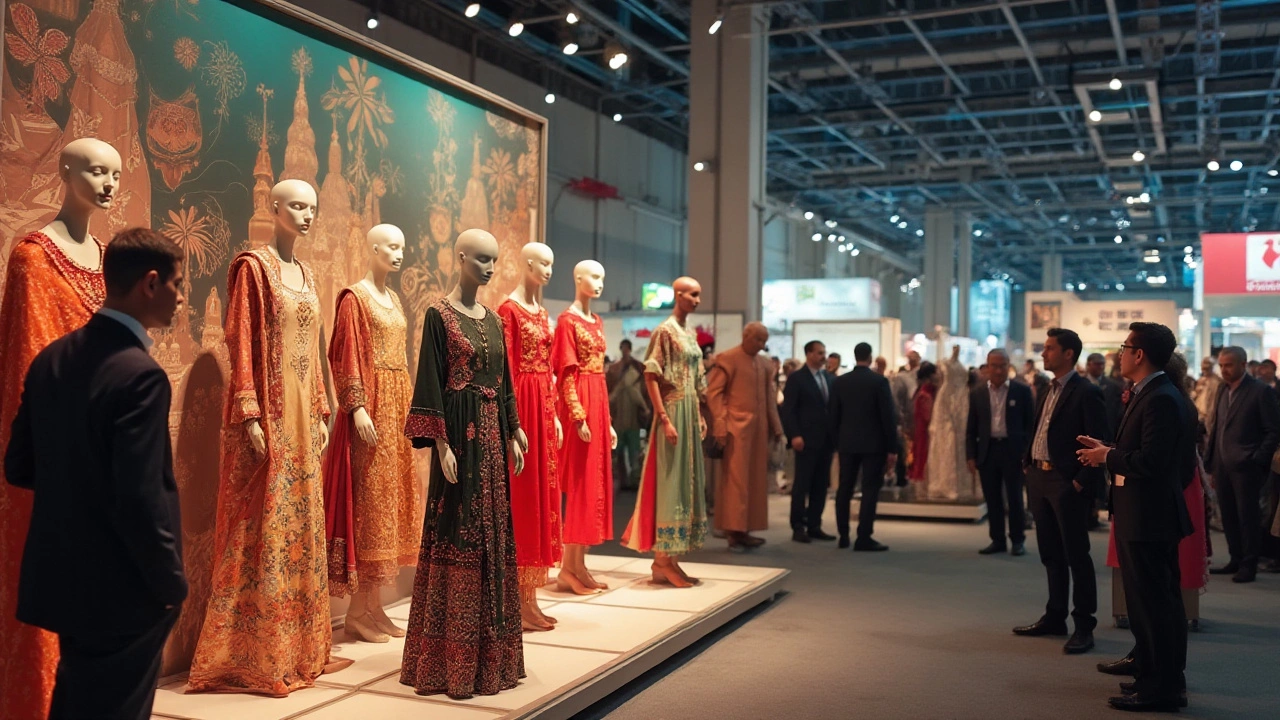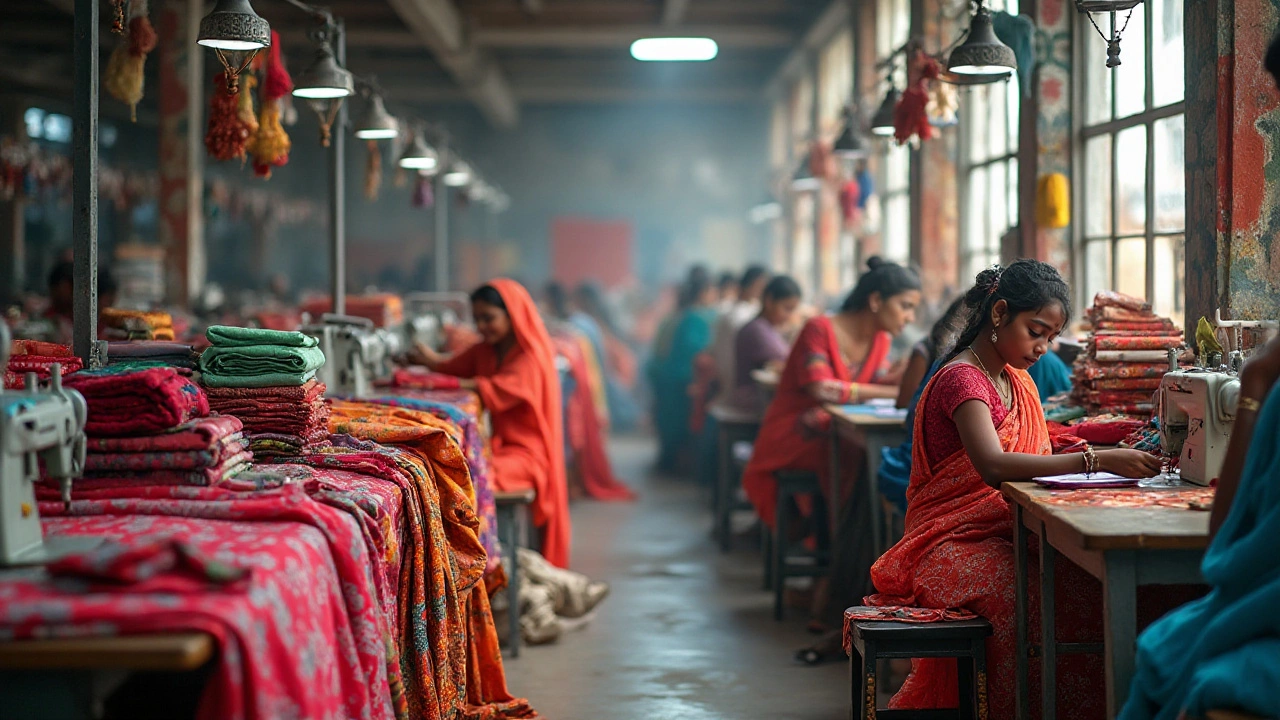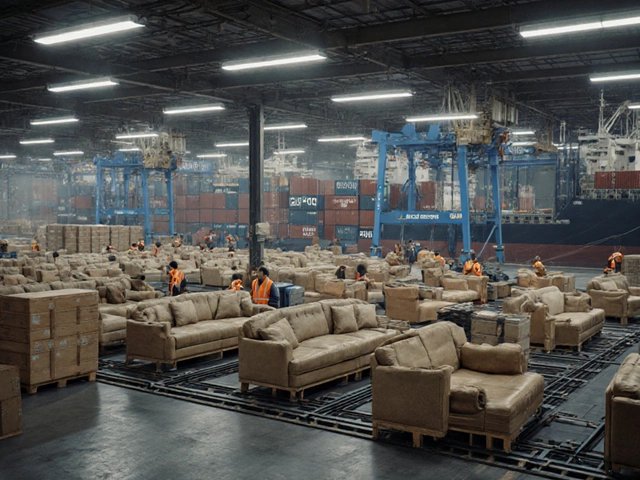India's textile industry stands as one of the most robust sectors of the country, not just for its contribution to the economy but also for its extensive export figures. Over the years, the country has carved out a niche for itself in the global market, becoming synonymous with quality and craftsmanship.
When it comes to garment exports, several Indian companies have established themselves as leaders, steering the nation's reputation upwards with each passing year. This piece delves into the biggest names in the industry, shedding light on their journey and achievements that have catapulted them to the top. We will also look into factors that contribute to their global success, providing a rounded view allowing for a deeper comprehension of India's position in the textile world.
- Overview of the Indian Garment Export Industry
- Key Players in the Market
- Factors Contributing to Success
- Challenges and Opportunities in Export
- Future Prospects of Indian Garment Exports
Overview of the Indian Garment Export Industry
India's garment export industry is a powerhouse sector that significantly impacts the nation's economy and offers livelihoods to millions. With decades of rich history backing its current status, this industry has witnessed phases of transformation. What stands out about Indian garment manufacturing is not just the quantity but the unique blend of tradition and innovation. The landscape is characterized by a myriad of textiles, including cotton, silk, and wool, which are then transformed into pieces resonating with skilled craftsmanship and intricate designs.
The global market has recognized India's potential, ranking it among the top garment exporters worldwide. Reports suggest that the textile and garment sector accounts for approximately 12% of India’s total exports, underscoring its prominence. This success can be attributed to a variety of factors such as the availability of raw material, a vast pool of skilled labor, competitive pricing, and the adaptability to meet ever-changing international fashion trends. An interesting facet of the industry is how it has managed to retain its traditional roots while embracing modern techniques, ensuring that Indian exports remain relevant and in demand.
Another vital element that propels India’s garment export industry is its governmental support through policies and initiatives that aid manufacturers. Schemes under the Ministry of Textiles aim to ease the export processes, providing fiscal benefits and infrastructural support to manufacturers. Programs focusing on skill enhancement and technological upgrades have further bridged the gap between traditional methods and contemporary demands. From introducing professional training programs to upgrading weaving techniques, these efforts have fortified India's standing in the global textile arena.
A notable mention is the contribution from Small and Medium Enterprises (SMEs) that have mushroomed across different parts of the country. These entities add vibrancy to the industry as they often infuse novelty and creativity into the export market. According to industry experts, these SMEs are crucial as they often introduce unique regional designs and fabric specialties into international markets, creating a diversified catalog that appeals to a broad audience globally.
"The resilience and adaptability of the Indian garment sector are what keep it not only afloat but thriving, especially in times of global market fluctuations," according to industry veteran Raghav Misra.
The Indian apparel export story is not just about statistics and numbers but also about people—the artisans, designers, and workers who add life to the textiles. Their stories, often built on decades-old techniques passed down through generations, reflect a triumph of heritage in a modern world. This blend of the old and new keeps India at the forefront, making its garment industry a well-respected name across continents. The demand for ‘Make in India’ clothing, boasting quality and affordability, continues to rise, strengthening the bridge between India and its international clientele.
Key Players in the Market
The Indian textile and garment industry teems with eminent names that have long made a mark on the global stage. One such giant is Bombay Dyeing, which is deeply entrenched in the Indian psyche, symbolizing high-quality fabric and visionary leadership. Their export ventures have seen massive growth, with an expanding footprint across several international markets. Known for their innovative designs and sustainable practices, Bombay Dyeing continues to be a bellwether in the garment export industry, adapting to the constantly evolving needs of the global consumer.
Another household name is Raymond, which is not just a brand but an emblem of trust and class. As a colossal force in the industry, Raymond's export business thrives on its profound manufacturing acumen and longstanding value chain efficiencies. Their state-of-the-art production facilities and attention to detail underscore their prominence as a top garment exporter in India. Raymond’s focus on suiting up the world has not only established them as a preferred brand overseas but also reinforced India's capability in garment production.
In the competitive landscape of garment export, Arvind Limited holds a distinctive position. Revered for its ability to assimilate cutting-edge technology with age-old textile traditions, Arvind has created a niche for itself as a sustainable apparel manufacturer. Through their strategic business model and commitment to eco-friendly solutions, Arvind Limited continues to achieve significant export growth. Their initiatives have garnered attention from global brands, adding to their repute and helping position Indian manufacturers as leaders in the textile space. Inclusion of their diverse product range and unwavering adherence to quality have ensured their success.
"Our commitment to embracing sustainable practices is unwavering and integral to our strategy. With robust technology and innovation, we aim to lead with purpose." — Sanjay Lalbhai, Chairman, Arvind Limited
Welspun India also claims a significant share of the pie in the garment export bracket. As one of the largest home textile manufacturers globally, their export services are not limited to apparel but extend to home essentials, contributing remarkably to India's revenue from textiles. Welspun's strategic tie-ups with retail giants like Walmart and Tesco underscore their influential presence and highlight the potential of Indian textiles on international ground. The company’s relentless drive for customer satisfaction and quality continues to foster its reputation as a reliable partner worldwide.
To express the industry’s broader reach and impact, Shah Export House stands out as a testament to the tenacity and innovation found in smaller, artisanal brands. Though not as large in scale as the previously mentioned behemoths, Shah Export House offers a compelling blend of traditional craft with contemporary styles, catering to niche markets across the world. They show how even smaller players play crucial roles in strengthening India’s garment export lineage, contributing to its vibrant economy and rich cultural heritage.
The clustering of these key players across the Indian textile landscape paints a picture of diversity and resilience. It is this variety that bolsters India’s position as a formidable player in the textile and garment export industry, showcasing the vast talent and ingenuity that define this sector. These companies, through their contributions, continue to elevate not just their brands but the overall prestige of the Indian garment export industry.

Factors Contributing to Success
When examining the pivotal elements that have made India’s textile giants so successful, it becomes essential to consider a combination of traditions and modern innovations. The Indian garment export industry has long been anchored by its centuries-old craft of weaving and dyeing, creating a blend of heritage and style that appeals across global markets. This deep-rooted expertise gives Indian manufacturers an edge, as they can produce intricate and customizable designs that others often cannot replicate. Such craftsmanship caters to varying international tastes, enriching the brand value of Indian garments universally.
The rise of India as a major apparel exporter can also be attributed to the strategic investments in technology and infrastructure. Modern factories equipped with advanced machinery ensure quality and precision, meeting stringent international standards. Government initiatives like 'Make in India' and export-friendly policies have further bolstered this sector's growth by attracting investments and simplifying regulatory processes. This mix of tradition and cutting-edge technology ensures that Indian manufacturers remain competitive and responsive to the dynamic demands of the fashion industry.
Another critical factor is the availability of a diverse and skilled workforce. India’s demographic advantage, with its large labor pool, provides abundant manpower at competitive costs, making it attractive for high-volume orders. Training initiatives have enhanced skill levels across various textile functions, thus increasing productivity and product quality. This robust workforce is complemented by a strong supply chain, from raw materials to finished goods, which guarantees efficiency in manufacturing and exporting processes.
“India's textile industry is not just about fabric and fashion; it is a reflection of civilization and craftsmanship, combining heritage with innovation.” — A leading industry analyst
The growing awareness of sustainable practices has driven Indian manufacturers to adopt eco-friendly processes as well. Robust sourcing of organic materials and eco-conscious dyeing techniques align with the global shift towards sustainability, gaining favorable attention in international markets. Companies embracing these practices not only appeal to environmentally-conscious consumers but also actively reduce their environmental footprint, showcasing responsible manufacturing to the world.
Let's not forget the role of strategic partnerships and collaborations. By aligning with international fashion houses and brands, Indian manufacturers gain insights into emerging trends and foster innovation. These alliances enhance market reach and critical product differentiation, which often leads to increased sales opportunities and brand visibility. Such collaborations place Indian companies in a sustainable growth trajectory, fostering creativity and varied product lines that resonate globally.
Challenges and Opportunities in Export
The garment exporter India faces a complex tapestry of challenges and opportunities as it navigates the global market. At the forefront, the industry grapples with the fluctuating demand from international buyers, which tends to sway with global economic conditions and changing fashion trends. Indian manufacturers often have to quickly adapt their production and design processes to keep up, which demands not only creativity but also strategic planning and efficient supply chain management. This ability to swiftly pivot is crucial, as delays or misalignments can lead to hefty losses or canceled orders, impacting the bottom line.
Another significant challenge is the intense competition from other emerging markets. Countries like Bangladesh and Vietnam offer fierce competition due to their lower labor costs and trade arrangements. However, Indian manufacturers have found ways to turn this into an opportunity by focusing on quality and unique craftsmanship, aspects that have always distinguished Indian textiles. They capitalize on India's rich heritage and the diverse tapestry of its skilled artisans to create products that stand out globally, offering value that transcends pure cost competitiveness.
On the environmental front, Indian garment exporters are increasingly recognizing the need to adopt sustainable practices. The global push towards eco-friendly products is not just a trend but a necessity, opening opportunities for those who embrace sustainable manufacturing. This includes implementing waste-reducing technologies, using organic materials, and ensuring fair labor practices. These steps not only help in expanding the market reach but also in building a brand that prioritizes people and the planet, resonating well with conscious consumers.
Moreover, the integration of technology in the manufacturing process has opened doors to numerous possibilities. From AI-powered design processes to automation in production, Indian garment exporters can now enhance efficiency, improve accuracy, and reduce lead times. This high degree of technological adoption positions India ahead in terms of innovation, setting benchmarks that many aspire to meet. Implementing these technologies requires upfront investment and training, but the long-term benefits make it a worthwhile endeavor.
Financial aspects also present both hurdles and openings. Exchange rate volatility can erode profit margins, making financial planning a challenge. Yet, access to competitive financing options and government incentives can bolster growth. The Indian government provides various schemes to support exporters, including duty drawbacks and export promotion capital goods schemes, which aid in reducing the operational burden and fostering an encouraging environment for growth.
In a quote illustrating the resilience and forward-thinking nature of the industry, a notable sector leader remarked, "The future belongs to those who innovate and adapt. Our strength lies not just in what we produce, but how we embrace change." This philosophy encapsulates the attitude of India's leading garment exporters, who continue to forge ahead by aligning their strategies with emerging global trends and consumer expectations.

Future Prospects of Indian Garment Exports
In the dynamic world of textiles, India's garment export sector holds a position of promising growth. As global fashion trends evolve, India is poised not just to keep pace, but to lead innovations that could redefine the industry. There's a growing emphasis on sustainable fashion, which could be a turning point for Indian manufacturers. Embracing eco-friendly practices is not just a trend but a necessary adaptation for long-term success, and Indian exporters are strategically positioning themselves to capture this niche market. By integrating sustainable methodologies in production, they are bridging traditional craftsmanship with modern eco-conscious demands.
Investments in technology are another avenue India is exploring to propel itself forward in the textile industry. With advancements in machinery and digital fabric printing, Indian manufacturers are now able to meet rapid demand without compromising quality. The rise of e-commerce platforms has expanded their reach significantly, allowing Indian players to cater directly to consumers worldwide. As more brands pivot online, the need for quick, reliable supply chains becomes paramount—an area where India's established logistics network offers considerable advantage. The future could see an increasing number of brands turning towards Indian exports, drawn by their adaptability and efficiency.
Despite its promising trajectory, the industry does face certain challenges. At the forefront are international trade regulations and tariffs that sometimes create hurdles for exporters. However, with strategic partnerships and trade agreements, India is steadily working to mitigate these barriers. Interestingly, according to a study by the Apparel Export Promotion Council, India’s garment exports are expected to grow by about 12% annually in the next five years. As the global economy stabilizes, a surge in demand for quality garments is anticipated, which positions Indian apparel in a beneficial light.
"India has the potential to double its share in global apparel exports if we focus on product diversification and innovation," said Naren Goenka, Chairman of AEPC in a recent industry conference.
Another intriguing aspect is the increasing number of startups entering the Indian textile scene, infusing fresh ideas and competition. These startups are often incubated with a strong digital-first approach, targeting younger demographics with personalized and adaptive fashion solutions. Collaborations between these startups and traditional manufacturers can harness the best of both worlds, creating a dynamic industry ready to meet future demands.
The prospects of Indian garment exports continue to shine brightly, thanks in part to the country’s commitment to quality and efficiency. The ongoing global focus on green initiatives and ethical manufacturing aligns well with India’s cultural and industrial ethos, thereby offering it an invaluable edge. As such, stakeholders in the Indian textile industry are not only optimistic but actively investing in innovations to ensure the future remains as bright as the colorful arrays of fabrics they produce.






